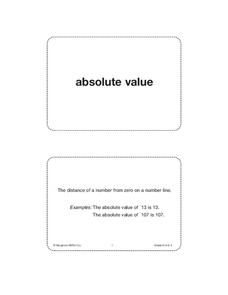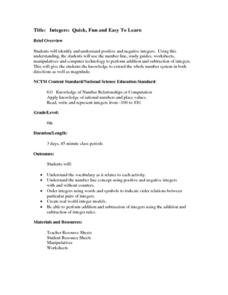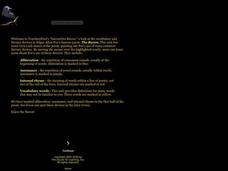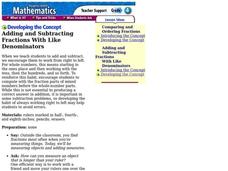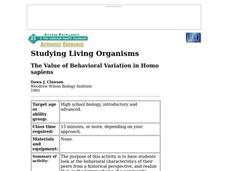Los Angeles County Office of Education
Assessment for the California Mathematics Standards Grade 3
Assess scholars' knowledge with a 22-page assessment that covers place value, patterns, probability, estimation, measurement, geometric figures; and their ability to add, subtract, multiply and divide proficiently.
Houghton Mifflin Harcourt
Unit 4 Math Vocabulary Cards (Grade 6)
Reinforce math vocabulary with a set of flash cards. Forty-eight cards offer boldly printed words, and their corresponding definition alongside an example with labels. Terms include absolute value, inverse operations, slope, and more!
National Security Agency
Integers: Quick, Fun and Easy To Learn
A good complement to any integers unit contains a three-day lesson plan about positive and negative integers, adding and subtracting integers, and how to find the additive inverse. Additionally, it provides all necessary...
Curated OER
Comparing Fractions with the Same Numerators, Assessment Variation
Have your class demonstrate their ability to compare fractions with this short multiple-choice assessment. Using the fractions 9/8 and 9/4, the students first make comparisons using both words and the greater than/less than signs. Next,...
CCSS Math Activities
Smarter Balanced Sample Items: 6th Grade Math – Claim 3
Communication is key. Eight sample items show how important communication and reasoning is for sixth grade mathematics. Part of the Claim 2-4 slide show series, the presentation uses concepts from fifth and sixth grade to illicit...
Scholastic
Step-by-Step Strategies for Teaching Expository Writing
A carefully crafted, logically organized, 128-page packet is an excellent addition to your unit on expository writing.
EngageNY
Markup and Markdown Problems
There is a 100 percent chance this resource will help pupils connect percents to financial literacy. Young mathematicians use their knowledge of percents to find markups and markdowns in financial situations in the seventh segment in a...
Curated OER
Journey to Topaz: KWHL Strategy
Japanese Internment and World war II are the focus of a KWHL strategy used to scaffold for a reading of Journey to Topaz, Yoshiko Uchida's story of 11-year-old Yuki Sakane and her family. Complete directions for the activity...
Curated OER
Comparing and Ordering Fractions
Third graders create fractions from concrete materials, then use paper fractions.
Curated OER
Great River Bend Adventure
Students use their imagination. They discuss the 4 C's of teamwork: Concentration, Communications, Coomperation, and Consideration. Students discuss the safety guidelines of the project. They complete a rope maze. The group walks...
Curated OER
Pizza, Pizza
Fourth graders investigate the concept of fractions. A pizza is used as a metaphor and example of practice for students. They use the appropriate methods of dividing numbers from a whole and into the fractional parts. Then students...
Curated OER
Adding and Subtracting Fractions with Like Denominators
Young scholars add or subtract fraction parts of mixed numbers before adding or subtracting the whole number parts. In this fractions lesson, students learn to use a ruler to help them add and subtract fractions with like denominators.
Curated OER
Birth of a Butterfly
Students demonstrate an understanding of insects and science as a whole and construct the life cycle of a butterfly using pasta. They first fold a piece of paper into four equal parts. In the upper left corner will be stage one (egg)....
Curated OER
Multiplicative Sequences
Students investigate the concepts related to the practice of multiplication facts. They look for number patterns in order to create an algorithm in order to find the correct sequencing of number patterning. The solutions are then...
Curated OER
The Language of Mathematics
Learners integrate the language, concepts and skills of math into the daily routine and classroom environment. They think mathematically by participating in short, daily, individual, small group, whole group and transitional activities...
Curated OER
Let's Celebrate!
Second graders, as a whole class, create a calendar of holidays using cards. Afterward, they add their birthdays to the calendar.
Curated OER
How Typical or Atypical is Your Community?
Students analyze and answer specific questions posed by the teacher about their community. They assess how typical a community is by comparing its characteristics to those of the whole nation. They determine how typical or atypical...
Curated OER
The Value of Behavioral Variation in Homo sapiens
Pupils look at the behavioral characteristics of their peers from a historical perspective, and realize that, in the larger scheme of a community, these behaviors do have some value, and that a society as complex as ours does need the...
Curated OER
Cell Transformation in Tobacco Leaf Disks
Students review the basic principles of plant cell structure, tissue culture, sterile technique, and cell transformation. Next students complete a plant transformation experiment using whole plant material in order to view evidence of...
Curated OER
Free Speech Comes At a Price
Young scholars use communicative activity strategy, Go, Ask and Tell, or more traditional whole text comprehension activity to read, discuss and explore issues in article, Free Speech Comes at a Price, by Hugh Mackay.
Curated OER
Science-Introduction to the Unit on Matter
First graders gain knowledge about solids, liquids and gases by taking a look at the things around them. They have to classify certain picture cards based on which category they feel the picture falls under. As a whole, the class...
Curated OER
Fraction Fun
Learners define properties of fractions and solve for them. In this algebra lesson, students rewrite fractions from mixed numbers to improper fractions. They reduce fractions using the GCF and convert the denominators correctly when...
Curated OER
Coping with Changes
Students build on knowledge of brain and nervous system in order to write about how their nervous systems help them cope with change in environment. Students navigate online sites to explore different parts of brain and nervous system.
Curated OER
Value Your Digits
Third graders work with place value. In this place value lesson, 3rd graders write three digit numbers and tell the place value of each number. They compare numbers and money, regroup, discuss the value of coins, and count money.

